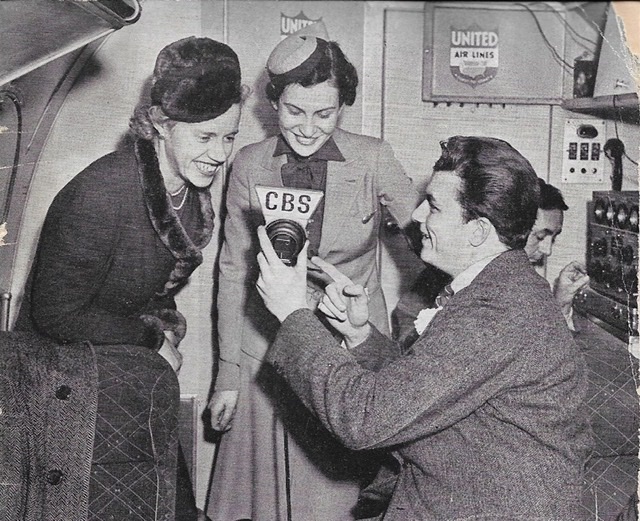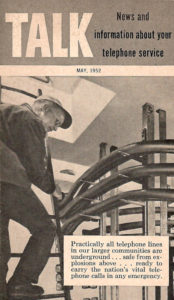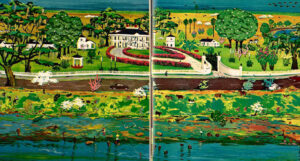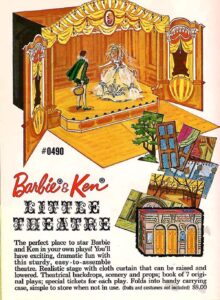Oh, the glamour of flying! Large crowds at the airport. Long lines at security. Your body jammed into the middle seat of a small, cramped row. You and your fellow travelers share the misery of vanishing legroom and a seat that reclines a whopping half an inch!
It wasn’t always that way. When flying was new it came with an atmosphere of glamour and luxury that is rarely duplicated today.
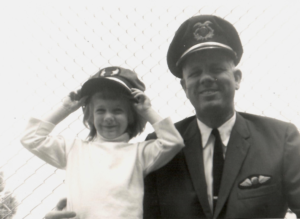
As the daughter of an airline pilot, we flew a lot when I was a kid. I remember one special trip to Florida. We sat in first class and the stewardess pushed a cart down the aisle which held a volcano surrounded by dry ice and filled with punch! Also the seats were wide and comfortable. The slogan of the time was “Three Feet for your Two Legs” aka there was plenty of legroom. We were traveling in style!
That was in the 70s, toward the end of aviation‘s golden age. Recently while perusing the offerings on eBay, I came across a treasure that showcased the beginning of this golden era. A pamphlet produced by CBS. A transcript actually, from one of their radio broadcasts in 1939. The series was called “Americans at Work” and this episode followed an airline stewardess into the skies. Airing only four years after the first female flight attendant was hired, this program introduced America to women who were workplace pioneers and to a new form of transportation.
Now usually in my blog I like to focus on the beautiful design of glorious products or brochures from years past. Here the product is just as glamorous, but the images are not visual, they are word paintings crafted by the writers of this radio episode. Descriptions so vivid and authentic, you can actually see yourself, in your mind’s eye, traveling through a starry night inside a beautiful propeller airplane. The hum of the powerful radial engines lulling you to sleep.
I’m going to break down the transcript for you into three different parts. Instead of posting each one on Friday, I’ll post all three this week so you can read them sooner. Part one is a dramatization of what life was like for a flight attendant named Polly, who worked on a typical night flight across the American skies in the late 1930s. Part two will continue following Polly on her journey. Part three will include an interview with one of the four Chief Stewardesses employed by United Airlines in 1939. CBS will also attempt to talk to a stewardess, live! One who was actually flying in the skies across America during the broadcast.
I’ll also make little comments here and there, but I will highlight them in red so you can easily tell them apart from the transcript.
So ready to go? Let’s start by meeting Polly, an “Airline Stewardess.”
================================================================
The announcer takes to the microphone to begin the show.
“This is a program to introduce you to a girl with one of the most interesting jobs in the country,” came the words over a radio over eighty years ago. “Another in Columbia’s series, Americans at Work. The young lady in the spotlight tonight one of the most important jobs in the whole complicated business of . . .
(Over loudspeaker) Announcing Trip No. 5: the Overland Flyer, ten-forty-five p.m. departure. Sleeper service for the West Coast, making stops at Cleveland, Chicago, Omaha, Salt Lake City, and Pacific points. Now loading at Gate 2.
GIRL: Your name, please? . . . (Pause) Yes, take any seat you want to (Pause) I’ll take your coat and hang it up for you. (Pause) Yes, we serve lunch on the plane. (Pause) Wouldn’t the little boy like to sit next to the window? (Pause) Yes, sir—there’s a map of the flight in the seat pocket.
VOICE: (Over loudspeaker) All abroad—Trip 5 Overland Flyer, ten-forty-five departure. Sleeper service for the West Coast. (Fade)
ANNOUNCER ALLEN: And in just a minute, another giant airliner departs—with pilot and co-pilot at the controls—and a slender pretty girl taking charge of the twenty-one passengers in the seats. She’s a brand new personality who made her appearance on the American scene less than ten years ago—and has become one of the most popular and capable career girls in America. This very minute while you sit comfortably in your living rooms, many of these girls are flying through the darkness somewhere over America (Airplane’s motor in as B.G.) thousands of feet over sleeping cities and country . . . performing their duties as casually as if they were hostess to twenty-some people in their own homes. (Motor up . . . as B.G.)
The first female flight attendant took to the skies in 1935.
FIRST GIRL: I’m stewardess on Trip 14—Seattle to Salt Lake City
SECOND: I’m on Trip 4—Dallas, Texas, to Memphis, Tennessee.
THIRD: I’m on Trip 9—Washington to Detroit.
FOURTH: Trip 11—Newark to New Orleans.
FIFTH: Kansas City to Brownsville, Texas—(Fade voices into hum of motors . . . motors down and gradually fade under following)
ANNOUNCER ALLEN: What kind of girl holds a job like this—how does she get it—what does it take? Well, a glance at a registration card at the personnel office of an airline gives us the frame to the picture.
VOICE: (Woman) A girl applying for the position of air stewardess must be 5′ 2″ to 5′ 5″ tall—must weigh not more than 120 pounds—be not more than twenty- five years of age—must have personality—attractive appearance—and must be a graduate registered nurse. She must be willing to be transferred on immediate notice (Fading) to any base in the country.
ANNOUNCER ALLEN: Now—meet the girl who has filled these requirements— (Girls’ laughter fading in over last part of speech)
POLLY: Hello, Joe. Yes, I’m on my way to the dispatcher’s office now. How’s our newest pilot?
YOUNG MAN: Swell. Just brought in Trip 17 from Newark—with a landing that was masterly if I do say it . . . rain and all.
POLLY: They’ll make you president yet, Joe! (Fading) See you soon.
(B.G. up and down) Well—Mr. Williams—what’s the report?
DISPATCHER: You’re taking Trip 15, Miss Stevens. Here are your readings. Temperature here 40—Chicago 68—ceiling 3000 . . . local rain . . . but flying conditions okay.
POLLY: Thanks. (Chuckle) no chance of a cancelation, is there?
DISPATCHER: (Kindly) What’s the matter? Got a heavy date?
POLLY: Not me! Just wondered
DISPATCHER: Well, the plane goes. Here’s the flight plan and wind readings. Your pilot is Captain Al Martin—first officer, Jack Blake.
POLLY: Jack—that’s grand. I know him.
DISPATCHER: Fine. You’ll probably come back with the return trip—but check the dispatcher at San Francisco when you get in.
POLLY: Thanks. I’ll be over at Reservations for the next few minutes.
(Background of voices and filter up and down)
RESERVATION MANAGER: You have a full plane, Miss Stevens—for the sleeper flight.
Douglas Aircraft made a special version of their famous DC3 for overnight passengers. They called it the Douglas Sleeping Transport. It had 14 sleeping berths for passengers on overnight, transcontinental journeys.
RESERVATION MANAGER: We had two cancellations, but two other passengers have taken the berths. Here’s the manifest.
POLLY: (Reading to herself, voice trails off) Anyone requiring any special attention?
RESERVATIONS: Well, John Conway, the movie hero, is on the plane . . . which ought to give you a buzz. ..
POLLY: Not me . . . but everybody else.
RESERVATIONS: Two first riders . . . and a woman with a baby . . . ten months old
POLLY: That’s swell—a baby passenger is wonderful.
RESERVATIONS: And that’s all we have any information on now.
POLLY: Okay. (Fading) I’m going over to check commissary now.
(Voices and motors up and down)
POLLY: And that finishes the list—except . . . oh, hello, Jack
CO-PILOT JACK: Hello, Polly. All set?
POLLY: You bet!
JACK: Glad to be doing a run with you.
POLLY: I’m surprised. I thought you were on the Chicago-Denver run.
JACK: Just got transferred. Know Captain Martin on this trip?
POLLY: No, I’ve never flown with him before.
JACK: He’s that big fellow talking to the dispatcher now. I’ll introduce you when he’s through. He’s swell.
POLLY: All right. Later. I’m going to report to the commissary now. Everything’s in but the baby kit— and some towels for the washroom. I’ve got to get them.
JACK: And they call it aviation! All right, sister! Keep the home fires burning. I’m going for some coffee. We take off in twenty minutes.
(Airplane motor warming up . . . Fade . . . Out)
(Voices and motors up and down)
FILTER: All aboard, Trip 15—Chicago—Omaha— Salt Lake City—San Francisco. All aboard Trip 15 . . . for San Francisco All aboard, Trip 15.
(Voices . . . up)
POLLY: Your name, please?
WOMAN: Anderson
POLLY: Oh, yes, Mrs. Anderson—you have a baby with you. Well, we’ll do everything to make you and the baby comfortable. Just take any seat.
WOMAN: Thank you.
POLLY: Your name, please?
MAN: Conway—John Conway.
POLLY: Oh, yes, Mr. Conway. I’d like to ask you something. When a celebrity travels, there are often a lot of people who want his autograph. If you don’t wish to be bothered, I’ll tell any passenger who asks about you.
CONWAY: Why that’s very considerate. I don’t mind —but it would be a relief not to be asked.
POLLY: Surely . . . (Fading) Your name, please? . . .
(Motors start to race in warming up . . . Slow down . . . Start and take off) (Take off)
Safety belts, everybody—we’re taking off.
ANNOUNCER ALLEN: And Polly and the little world she presides over—a small, warm, well-lighted world— take off into the night. Outside the humming propellers cut through the darkness—the tiny red and green lights on the wing tips gleam through the rain. Inside twenty-one passengers settle down to read or doze, and Polly tackles the job for which four weeks of hard training, and over 10,000 miles of flying have prepared her.
(Soar of motor up . . . Fade down and into baby cry . . . Motor to very faint B.G.)
WOMAN: Oh, dear—I thought he’d sleep right through—but the motors must have wakened him as we got into the plane.
POLLY: A little bit of warm milk might put him back to sleep.
WOMAN: I know it would—but we don’t stop for an hour or so, do we?
POLLY: I’ll fix a bottle for you right here on the plane.
WOMAN: You carry baby bottles on the plane?
POLLY: We certainly do—and over 250 more articles —from cleansing tissues to an electric razor. I’ll have the bottle in a jiffy.

Can you imagine? 250 articles, carried on every fight? When I was a kid I collected decks of airline playing cards. They provided them in those days. Each pack had an airplane or logo design. You could take them home! Now you’re lucky if you get a bag of peanuts, but to continue…
(Baby subsides as though falling into sleep)
Woman (Laughs) I don’t think you’ll need it—he’s going to sleep.
POLLY: They usually do—the hum of the motors is very soothing.
(Buzz of button)
SECOND WOMAN: May I have a drink of water, please?
POLLY: (Slightly off . . . Fading in) Why certainly. Wouldn’t you like something else . . . tea . . . or coffee . . . or hot chocolate?
SECOND WOMAN : Perhaps later—but just a glass of water now.
POLLY : Certainly.
================================================================
We’ll leave Polly now as she scurries off to bring her passenger a glass of water. I will continue following her adventures through the starry skies in another post very soon. Until then remember: GVS is your home for Glorious Vintage Stuff!
